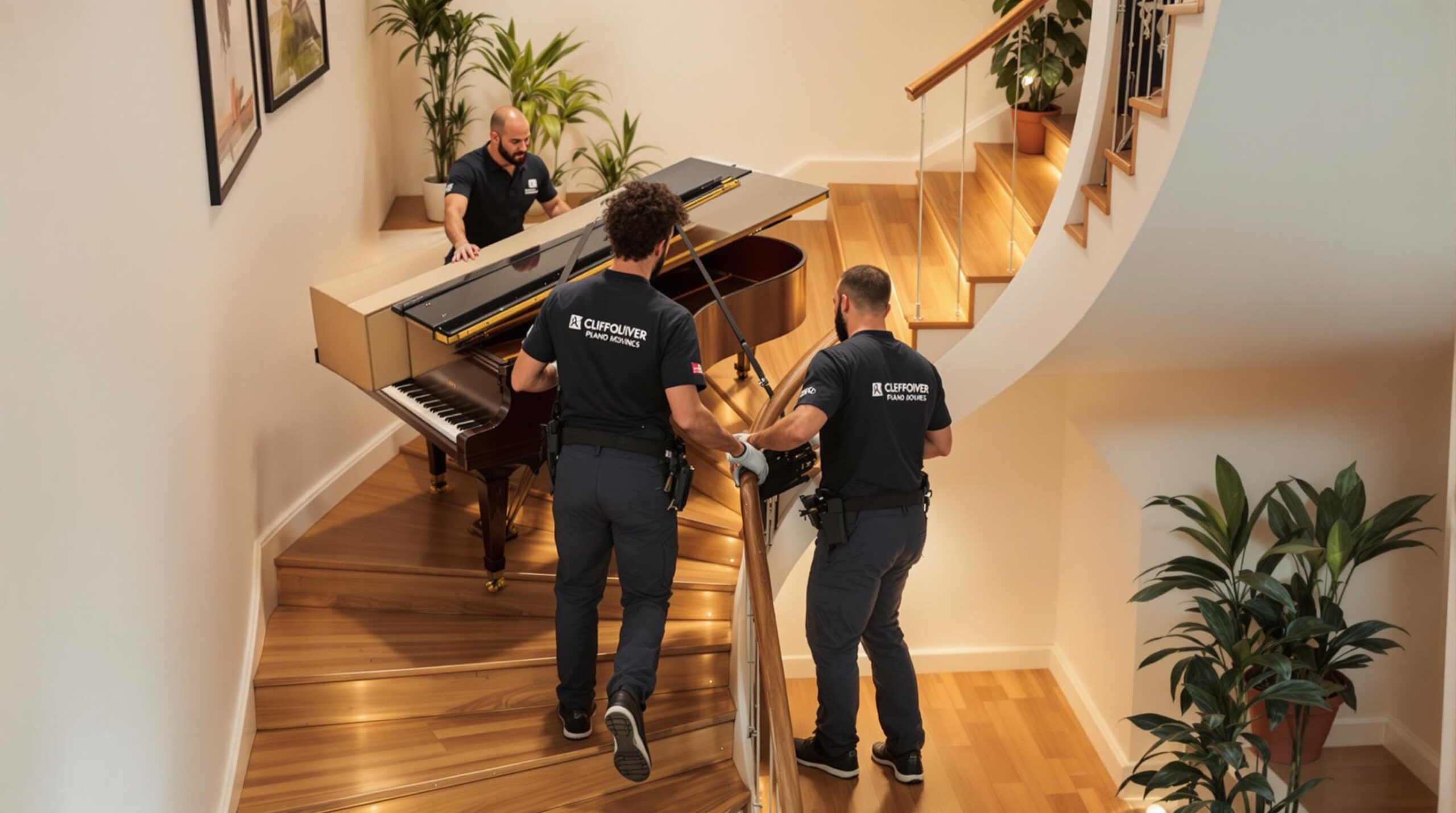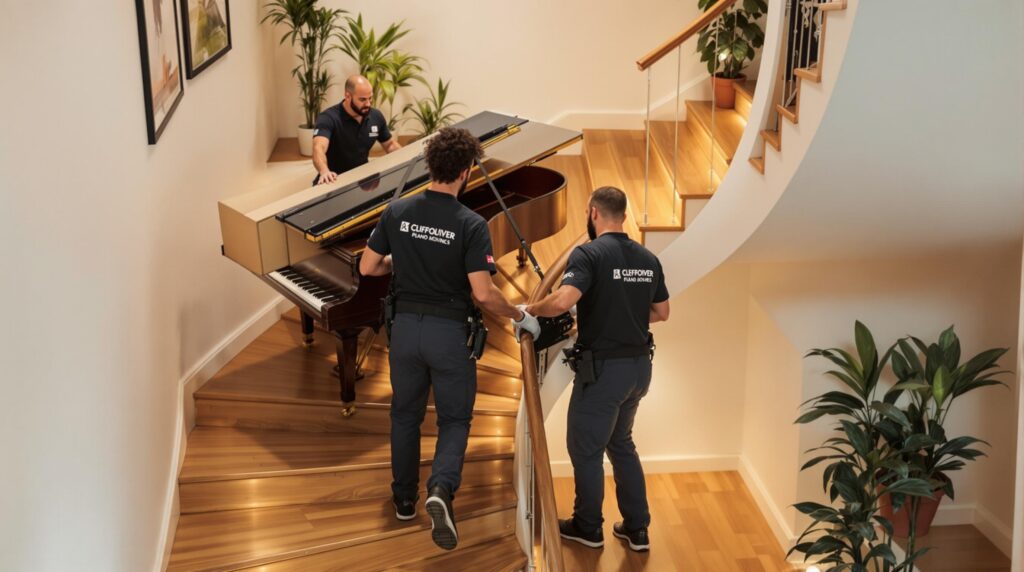
Moving a piano on stairs is challenging but doable with the right approach. Here’s what you need to know:
- Pianos are heavy and awkward: Upright pianos weigh 300–500 lbs, while grand pianos can exceed 1,000 lbs.
- Risks: Injuries, piano damage, and property damage are common without proper planning.
- Key steps:
- Measure everything: Piano dimensions, stairway width, ceiling height, and landing space.
- Tools you’ll need: Piano dollies, moving straps, blankets, stair ramps, and safety gear (steel-toed boots, gloves, etc.).
- Teamwork matters: At least 4–6 people with assigned roles and clear communication.
Quick Tips:
- Always keep the piano upright. Tilting more than 45° risks internal damage.
- Protect surfaces: Use padding, corner guards, and non-slip mats.
- Hire professionals: Experts like Cooper Piano ensure safety and precision, especially for tight staircases or heavy instruments.
Moving a piano without the right preparation can be risky and costly. Professional movers reduce the chance of accidents and make the process smoother.
Before You Move
Measuring Your Space
Start by measuring your piano: note its height (floor to the highest point), width (widest span), and depth (front to back).
Then, check your stairway clearances:
| Measurement Point | Minimum Required | Recommended |
|---|---|---|
| Stairway Width | 36 inches | 48 inches |
| Ceiling Height | 84 inches | 96 inches |
| Landing Space | 48 x 48 inches | 60 x 60 inches |
| Doorway Width | 32 inches | 36 inches |
Add 4–6 inches to these measurements to account for padding and equipment, especially in tight corners or on landings. These measurements will help you determine the tools and team you’ll need.
Required Tools and Materials
To move a piano safely, you’ll need the following equipment:
- A piano dolly that can hold at least 1,000 lbs.
- A 4-wheel furniture dolly for flat surfaces.
- Moving straps (2 inches wide) rated for 1,500 lbs. or more.
- Moving blankets or padding (at least 6–8 blankets).
- A stair ramp designed specifically for piano moving.
- Safety gear, including steel-toed boots, work gloves, and back braces.
Keep everything within reach, and have extra straps and padding on hand as backups.
Building Your Moving Team
Put together a reliable team. Assign a leader to manage the process, 4–6 lifters to handle the heavy lifting, and one spotter to watch for obstacles or hazards. Make sure everyone has the right safety gear and understands their role. With accurate measurements, the right tools, and a dependable team, you’ll be ready to tackle the next steps and ensure a safe move.
Safety Steps
How to Lift Correctly
To lift safely, keep your back straight and bend at the knees. Stand with your feet shoulder-width apart, with one foot slightly forward for better balance. Grip the piano or straps firmly with both hands, keeping them close to your body.
When lifting, focus on the following:
- Engage your core muscles
- Push upward using your legs, not your back
- Keep the weight balanced
- Take small, steady steps
- Communicate clearly with your team
These steps will help you lift safely while minimizing the risk of injury and protecting the piano.
Damage Prevention
To avoid damage to both the piano and your surroundings, follow these precautions:
| Area to Protect | Method | Purpose |
|---|---|---|
| Piano corners | Corner guards with foam | Prevent impact damage |
| Stair railings | Removable rail covers | Avoid scratches and dents |
| Wall corners | Corner protectors | Prevent scuffs |
| Stair treads | Non-slip rubber mats | Ensure secure footing |
| Piano keys | Locking key cover | Protect keys from damage |
Always keep the piano upright while moving it. Tilting it more than 45 degrees can harm the internal mechanisms. Use moving blankets to cushion the piano and shield it from accidental bumps or scrapes.
Safety Equipment
Everyone involved in the move should wear proper safety gear:
- Steel-toed boots: Protect your feet in case of dropped items
- Work gloves: Improve grip and shield your hands
- Back support belts: Help maintain good posture
- Non-slip shoe covers: Increase traction on stairs
- Hard hats: Shield against overhead hazards in tight spaces
Keep a first aid kit nearby, and establish clear communication among team members. Use specific verbal commands like "lift", "hold", and "set down" to coordinate movements and avoid confusion during critical moments.
Moving Instructions
Wrapping and Strapping
Securely wrapping and strapping your piano is a must before any move. Experts, like those at Cooper Piano, recommend using high-quality materials and proven techniques to safeguard every part of the instrument.
Corner and Turn Techniques
Getting a piano around corners takes careful coordination and teamwork. Skilled movers rely on planned techniques to handle tight turns, keeping the piano steady and avoiding damage. Staircases with unique layouts may require additional approaches.
Moving on Different Stairs
Staircases – whether straight, spiral, or carpeted – pose specific challenges during a piano move. Professional movers are equipped with the right tools and know-how to handle these situations with care. For the safest option, consider Cooper Piano’s expert moving services.
sbb-itb-b8bc1ab
How to Move a Piano Down Stairs | How Professionals Piano …
Problem Solving
This section builds on earlier safety strategies to address challenging moving scenarios.
Managing Multiple Floors
Moving a piano across multiple floors requires careful planning. Landings and floor transitions can be tricky, so maintaining balance is critical. Professional movers often use landings as rest points to adjust grip and ensure stability.
"There was never a doubt that Cooper Piano was going to be able to move and set up the piano at its new home in the same condition it left its previous home. Highly recommend!" – Barrett E. Lowery [1]
This method helps prepare for piano-specific challenges that might arise.
Moving Different Piano Types
Each piano model presents its own set of challenges. While balance techniques stay the same, factors like weight distribution and turning radius can differ greatly. For instance, Amy Caloritis shared her experience moving a vintage player piano multiple times, highlighting the complexity of handling specialized instruments [1].
External factors, such as weather, can make these moves even more complicated.
Weather Concerns
Bad weather adds another layer of difficulty, especially when dealing with stairs. To protect the piano and ensure safety, professionals use:
- Moisture-resistant covers to shield the piano from rain or humidity
- Non-slip equipment for better grip during the move
- Temperature monitoring to avoid extreme conditions
A great example is Kate Guanci’s family heirloom – a grand piano from the early 1900s. Its preservation depended on careful planning during adverse weather [1]. In some cases, professionals may even reschedule moves to avoid potential damage.
"If you want timely, courteous, professional people to move your piano without damaging it, Cooper is the only way to go. Every time we move we continue to receive the same consistent experience." – Matt Garlick (Plurpp) [1]
After the Move
Checking for Damage
Once your piano is in its new location, give it a careful inspection. Look for any scratches, dents, or scuffs on the exterior. Test the keys, pedals, and internal mechanisms to ensure everything is working as it should. Don’t forget to check the surrounding walls and floors for any marks left during the move. Take photos of any damage, especially around corners and legs where stress is often concentrated. This documentation can be useful for insurance claims. Once you’re satisfied with the condition of your piano, shift your focus to maintaining it.
Piano Care After Moving
The vibrations and movement during the relocation can impact your piano’s sound. Scheduling a professional tuning within a few weeks is key to restoring its performance. To ensure your piano is well cared for, consider reaching out to Cooper Piano. With over a century of experience, they specialize in tuning and servicing pianos.
Professional Moving Services
Moving a piano, especially through tight spaces or stairs, requires skill and proper tools. Professional movers are trained to handle these challenges safely, ensuring your piano is protected. Many also provide post-move tuning to maintain sound quality. If you need expert help, Cooper Piano offers reliable services to keep your instrument safe during even the trickiest moves.
Conclusion
Key Takeaways
Moving a piano up or down stairs is no small task. It requires careful planning, the right tools, and enough manpower to get the job done safely. Without these, you risk injury and damage to the piano. Attempting a DIY move can quickly turn into a costly mistake.
Why Choose Cooper Piano?
This is where professional services make all the difference. With over 100 years of experience in the piano industry, Cooper Piano specializes in handling complex moves, including staircases. Their teams are trained to use the proper techniques and tools, ensuring both safety and precision.
Cooper Piano doesn’t just stop at moving. They also offer post-move services like tuning and maintenance to keep your piano in excellent condition after relocation. Their attention to detail and expertise make them a trusted choice for piano owners.
"Along with doing the complete restoration of my great grandmother’s grand piano (c.1900), they have also moved it three times for me. The crew is polite, professional and pretty dang fun to be around! The piano is my prized possession and I wouldn’t trust it in the hands of anyone other than Cooper!" – Kate Guanci [1]
Whether you’re moving between floors or to a new home, Cooper Piano’s skilled team ensures your piano arrives safely and continues to perform at its best.

